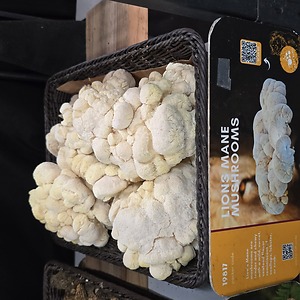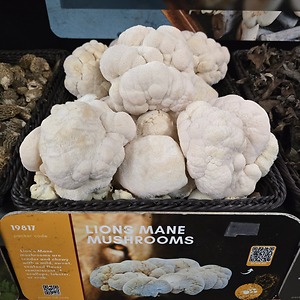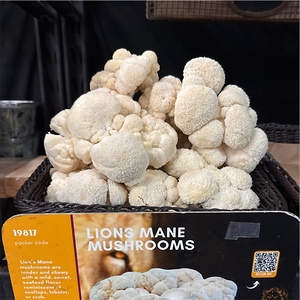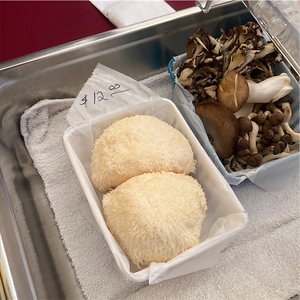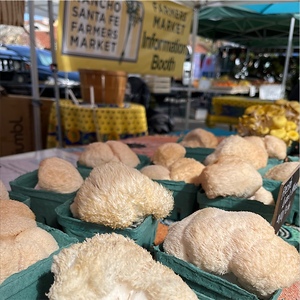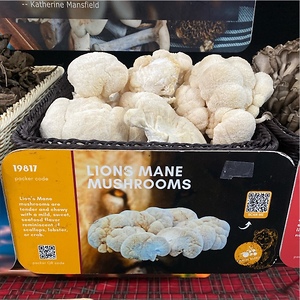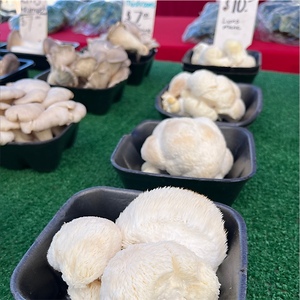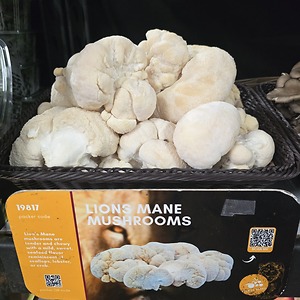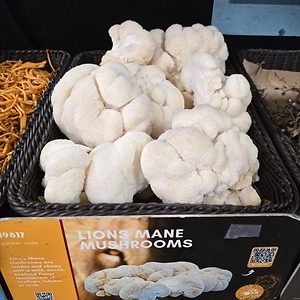

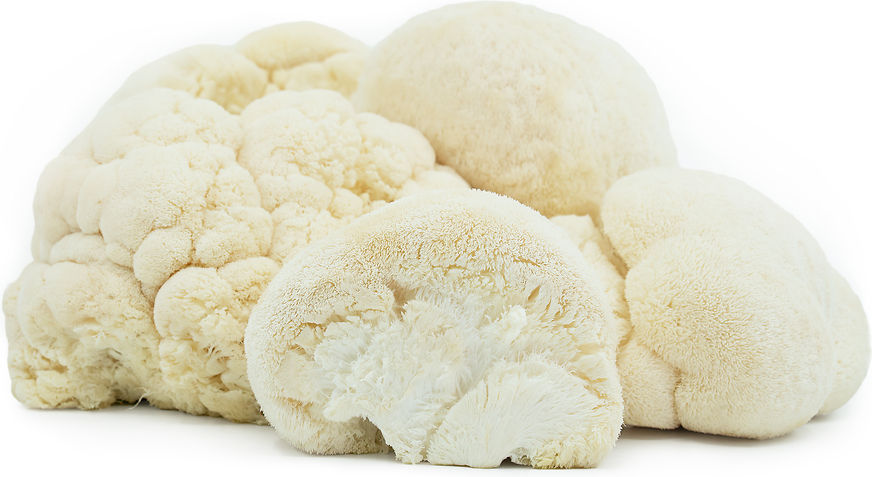
Lion's Mane Mushrooms
Estimated Inventory, lb : 0
Description/Taste
Lion’s Mane mushrooms vary in size, depending on the growing environment, and can develop into large species with fruiting bodies averaging 10 to 30 centimeters in diameter. The mushrooms typically exhibit a lumpy, round to oval shape and grow from a singular base, sometimes resembling cauliflower. The exterior showcases ivory, white, and cream-colored hues and is covered in soft spines ranging from 1 to 5 centimeters in length. Wild forms of Lion’s Mane often feature longer spines that hang freely, giving the spines a pointed, tipped look. Lion’s Mane mushrooms are a delicate, soft, and fragile species, being easily bruised and discolored. The surface can sometimes bruise brown-yellow or green with age and rough handling. Each spine on the mushroom’s surface releases white spores, a natural method for the species to expand and propagate. Underneath the surface, Lion’s Mane mushrooms reveal ivory to cream-colored flesh when sliced or torn open, and the flesh is spongy, springy, and thick. Lion’s Mane mushrooms become tender, chewy, and succulent when cooked. More mature mushrooms may also become tougher with age. Lion’s Mane mushrooms are known for their meat-like texture when cooked and have a mild, sweet, savory, subtly nutty, neutral flavor. Some consumers note that the species can taste like crab, scallops, and lobster, but this flavoring is very light and depends on the mushroom’s age and the region where it is grown.
Seasons/Availability
Wild Lion’s Mane mushrooms are available in the late summer through fall. In some regions, the species may also appear throughout the winter. Commercially cultivated Lion’s Mane mushrooms are grown on a substrate year-round.
Current Facts
Lion’s Mane mushrooms, botanically classified as Hericium erinaceus, are a wild, ancient species belonging to the Hericiaceae family. The species is a type of tooth fungus, a name given to a grouping of fungi with a soft, spine-like appearance. Several similar Hericium species are sometimes generally categorized under the Lion’s Mane name, but it is important to note that Hericium erinaceus is the main and most common species. Lion’s Mane mushrooms grow on dead or decomposing wood and are typically individual mushrooms. The fast-growing fungi can be found on the sides of trees up to twelve meters in height and are named for their soft-spined appearance, which is said to resemble the hair in a lion’s mane. Historically, Lion’s Mane mushrooms were foraged from the wild as a medicinal and culinary delicacy. The species has since become successfully cultivated, expanding availability to meet rising demand. Lion’s Mane mushrooms are known by several names worldwide, including Bearded Tooth fungus, Pom Pom mushrooms, Monkey’s Head mushrooms, and Mountain Priest mushrooms. Despite its ability to be commercially produced, the species has no toxic look-a-likes and is a favorite of foragers for its distinct appearance and easy-to-spot nature. Lion’s Mane mushrooms are valued for their dense texture and mild flavor and are used in cooked culinary dishes worldwide as a textural ingredient.
Nutritional Value
Lion’s Mane mushrooms are a source of calcium and phosphorus to support bones and teeth, vitamin D to boost immune health, iron to develop the protein hemoglobin for oxygen transport through the bloodstream, and potassium to balance fluid levels within the body while replenishing electrolytes. Lion’s Mane mushrooms also provide magnesium, zinc, copper, and manganese to control nerve functions, maintain metabolism, produce red blood cells, and assist the body in creating energy. In natural medicines worldwide, Lion’s Mane mushrooms are incorporated into tinctures, tea, supplements, and decoctions for their ability to enhance cognitive functions. The species is also believed to have anti-inflammatory and immune-boosting properties and can lessen anxiety. In North America, some indigenous tribes would dry and grind the mushrooms into a powder. This powder was later topically applied to a wound to help slow and stop bleeding. Lion’s Mane mushrooms were also consumed as a spiritual tool for indigenous people groups to become closer or more in tune with the gods.
Applications
Lion’s Mane mushrooms have a mild, subtly sweet flavor suited for cooked preparations. The mushrooms should be brushed clean or lightly washed before use, as their soft spines often trap dirt and debris. They should also be dried thoroughly before cooking as the mushrooms are absorbent. Lion’s Mane mushrooms release moisture when heated, and it is recommended that they be dry sautéd in a pan to release excess liquid. Once the moisture is released, aromatics, seasonings, and fats can be added to the pan for additional flavoring. Lion’s Mane mushrooms are praised for their meat-like consistency and can be easily pulled apart like crab or lobster. This quality allows the mushrooms to be used as a meat substitute for seafood, poultry, or tofu. Try pan-searing slices of Lion’s Mane mushrooms into a steak and serve with a balsamic glaze or chimichurri sauce. They can also be cooked and shredded for pulled meat in barbeque recipes, braised and served with potatoes, or layered into sandwiches. In North America and Europe, Lion’s Mane mushrooms are shredded into vegetarian crab cakes, cooked into gratins, or used as a filling in tacos. They have a neutral flavor, allowing them to be added to soups, curries, and stews, tossed into salads, stirred into pasta dishes, or simmered into risotto with other mushrooms for a complex flavoring. In Asia, Lion’s Mane mushrooms are popularly stir-fried with garlic, sesame oil, and soy sauce, added to rice and noodle dishes, or incorporated into variations of bibimbap. They are also sauteed with vegetables as a comforting winter dish. Beyond culinary preparations, Lion’s Mane mushrooms are sometimes used to make coffee and tea. Lion’s Mane mushrooms pair well with aromatics such as garlic, ginger, onions, sesame oil, and soy sauce, herbs including thyme, parsley, rosemary, and sage, kohlrabi, spinach, leeks, lemon, carrots, bell peppers, broccoli, and snap peas. Whole, unwashed Lion’s Mane mushrooms will keep for a few days to one week when stored in a paper bag in the refrigerator. The mushrooms can also be cooked and frozen for a couple of months.
Ethnic/Cultural Info
Lion’s Mane mushrooms are called Yamabushitake in Japan, a name derived from a group of monks who reside in the mountains. Yamabushitake translates from Japanese to mean “those who sleep in the mountains,” and the name is taken from the Yamabushi people. The Yamabushi reside in Tohoku, the northernmost region of Honshu Island. This region is filled with forests, isolated sacred mountains, and seasonally snow-filled terrain. The mountains were deemed sacred around 593 CE when Japanese Prince Hachiko escaped political turmoil after his father was assassinated. The prince fled to Mount Haguro as it was said he could encounter the Goddess of Mercy, Kannon. During his time in the mountains, Prince Hachiko created the center for Shugendo, a Japanese practice of worshipping nature and interweaving ideas from Taoism, Shinto, and Buddhism. Shugendo became the belief of the Yamabushi, and the people chose the region for the sacred mountains. Each mountain has a different meaning and purpose. Mount Haguro represents the present happiness, Mount Yudono symbolizes the future and rebirth, and Mount Gassan represents the past, where ancestors reside. The Yamabushi spend their time training and practicing spiritual and emotional disciplines around the three sacred mountains. They are connected to the area's natural flora and fauna and deeply value Lion’s Mane mushrooms for their medicinal properties. The Yamabushi use Lion’s Mane mushrooms for increased focus during meditation, and they also incorporate the foraged fungi into medicinal teas and tonics. Lion’s Mane mushrooms have become a symbol of strength and clarity for the Yamabushi people, and various garments are sometimes worn around the monk’s necks, which are supposed to resemble the shape of a Lion’s Mane. The Yamabushi’s extensive use of the mushroom eventually led people to believe that Lion’s Mane mushrooms were a natural “gift from the mountain gods,” and the variety acquired the name Yamabushitake in Japanese commercial markets in honor of their history with the Yamabushi people.
Geography/History
Lion’s Mane mushrooms are native to the Northern Hemisphere and have been growing wild in temperate regions of Asia, Europe, and North America since ancient times. The species remained primarily wild for centuries and was foraged as a seasonal medicinal and culinary ingredient. Lion’s Mane mushrooms are a saprotrophic species, meaning they feed on dead or decaying wood and are commonly found growing on hardwood trees, including Sycamore, American Beech, Chestnut, Maple, and several other types. The first written record of Lion’s Mane dates back to the Tang Dynasty in China, sometime between 618 and 907 CE. During this dynasty, Lion’s Mane mushrooms were noted as a species reserved for royalty and were consumed in various preparations to support overall health and enhance vitality. Lion’s Mane mushrooms also became an essential ingredient in Traditional Chinese Medicine, expanding the species’ use to all social classes over time. Commercial cultivation of Lion’s Mane mushrooms began around 1988, and production was centralized in Asia, mainly China. Other regions of the Northern Hemisphere also later cultivated the species as demand increased, and commercial production allowed for year-round availability in some markets. Today, Lion’s Mane mushrooms are still foraged from wild populations and commercially grown for sale in fresh markets. The species is also prepared into tinctures, powders, capsules, and other medicinal forms through health stores and online retailers worldwide.
Recipe Ideas
Recipes that include Lion's Mane Mushrooms. One
Podcast



